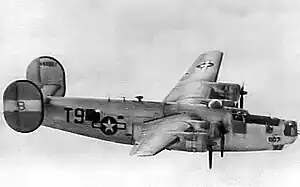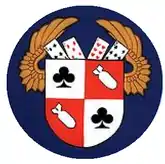784th Bombardment Squadron
The 784th Bombardment Squadron is the senior predecessor of the 784th Tactical Air Support Training Squadron. It was organized in August 1943 as a heavy bomber unit. After training in the United States with Consolidated B-24 Liberators, the 784th moved to England, where it participated in the strategic bombing campaign against Germany. Following V-E Day, it returned to the United States, where it began training with Boeing B-29 Superfortresses, but was inactivated in October 1945.
| 784th Bombardment Squadron (later 784th Tactical Air Support Training Squadron) | |
|---|---|
 Squadron B-24 Liberator[lower-alpha 1] | |
| Active | 1943-1945; 1964 |
| Country | |
| Branch | |
| Role | strategic bombardment |
| Engagements | European Theater of Operations |
| Insignia | |
| 784th Bombardment Squadron emblem[1] |  |
| World War II fuselage code[1] | T9 |
The unit's second predecessor is the 784th Tactical Fighter Squadron, which was briefly active at George Air Force Base, California in 1964. The two inactive squadrons were consolidated in September 1985, but the consolidated 784th Tactical Air Support Training Squadron has never been active.
History
Training in the United States
The 784th Bombardment Squadron was activated at Alamogordo Army Air Field on 1 August 1943 as one of the four original squadrons of the 466th Bombardment Group. After training there with Consolidated B-24 Liberators, the squadron departed for the European Theater of Operations in February 1944.[2][3] The ground echelon proceeded to the port of embarkation for transport to Europe by ship, while the air echelon ferried their Liberators via the South Atlantic Ferry route.[4]
Combat in Europe
The squadron arrived at its combat station, RAF Attlebridge in England in March 1944. It flew its first combat mission on 22 March in an attack on Berlin, Germany. It engaged primarily in the strategic bombing campaign against Germany, with targets that included oil refineries and facilities at Bohlen and Misburg, marshalling yards at Liège and Saarbrücken, factories at Brunswick, Kempten and Eisenach, repair facilities at Reims, mining facilities near Hamburg and airfields at Saint-Trond and Chartres.[3]
The squadron also flew air support and air interdiction missions. It attacked pillboxes in Normandy on D-Day to support Operation Overlord and performed interdiction missions against targets beyond the beachhead in the following days. During Operation Cobra, the breakout at Saint Lo in July, it bombed German positions in the city. It attacked lines of communication during the Battle of the Bulge in December 1944 and January 1945. On 24 March 1945, it supported Operation Varsity, the airborne assault across the Rhine by attacking a military air base at Nordhorn. The squadron's last mission of the war was flown on 25 April 1945 against electrical facilities at Traunstein.[3]
Return to the United States and inactivation
Following V-E Day, the squadron returned to the United States. The air echelon began flying their B-24s back to the United States in the middle of June, while the ground echelon sailed aboard the RMS Queen Mary on 6 July.[4] The squadron reassembled at Sioux Falls Army Air Field, South Dakota in late July 1945. In August, the squadron moved to Davis-Monthan Field, Arizona to begin training with the Boeing B-29 Superfortress. However, with the surrender of Japan, the squadron was inactivated in October as Davis-Monthan transitioned from a training base to a storage facility.[2][3][5]
Tactical fighter training

The squadron's other predecessor, the 784th Tactical Fighter Squadron, was activated at George Air Force Base, California in April 1964 as an element of the 32d Tactical Fighter Wing. The unit began training with the McDonnell F-4 Phantom II, when the Air Force decided to replace the 32d Wing with the 8th Tactical Fighter Wing,[6] which moved on paper to George from Japan.[7] The squadron inactivated and its personnel and equipment were transferred to the 68th Tactical Fighter Squadron.[8]
The two squadrons were consolidated as the 784th Tactical Air Support Training Squadron on 19 September 1985.[9]
Lineage
- 784th Bombardment Squadron
- Constituted as the 784th Bombardment Squadron (Heavy) on 19 May 1943
- Activated on 1 August 1943
- Redesignated 784th Bombardment Squadron, Heavy in 1944
- Redesignated 784th Bombardment Squadron, Very Heavy on 5 August 1945
- Inactivated on 17 October 1945[2]
- Consolidated with the 784th Tactical Fighter Squadron as the 784th Tactical Air Support Training Squadron on 19 September 1985[9]
- 784th Tactical Air Support Training Squadron
- Constituted as the 784th Tactical Fighter Squadron on 6 April 1964[10]
- Activated on 1 April 1964
- Inactivated on 25 July 1964[11]
- Consolidated with the 784th Bombardment Squadron as the 784th Tactical Air Support Training Squadron on 19 September 1985[9]
Assignments
Stations
- Alamogordo Army Air Field, New Mexico, 1 August 1943
- Kearns Army Air Base, Utah 31 August 1943
- Alamogordo Army Air Field, New Mexico, 24 November 1943 – 10 February 1944
- RAF Attlebridge (AAF-120),[12] England 9 March 1944 – c. 6 July 1945
- Sioux Falls Army Air Field, South Dakota, 15 July 1945
- Pueblo Army Air Base, Colorado, 25 July 1945
- Davis-Monthan Field, Arizona, 26 August–17 October 1945[13]
- George Air Force Base, California, 1 April–25 July 1964[14]
Aircraft
Campaigns
| Campaign Streamer | Campaign | Dates | Notes |
|---|---|---|---|
| Air Offensive, Europe | 9 March 1944 – 5 June 1944 | 784th Bombardment Squadron[2] | |
| Air Combat, EAME Theater | 9 March 1944 – 11 May 1945 | 784th Bombardment Squadron[2] | |
| Normandy | 6 June 1944 – 24 July 1944 | 784th Bombardment Squadron[2] | |
| Northern France | 25 July 1944 – 14 September 1944 | 784th Bombardment Squadron[2] | |
| Rhineland | 15 September 1944 – 21 March 1945 | 784th Bombardment Squadron[2] | |
| Ardennes-Alsace | 16 December 1944 – 25 January 1945 | 784th Bombardment Squadron[2] | |
| Central Europe | 22 March 1944 – 21 May 1945 | 784th Bombardment Squadron[2] |
References
Notes
- Explanatory notes
- The aircraft in the photograph is clearly a squadron airplane. It is identified in the photograph as Consolidated B-24J-180-CO Liberator, serial 44-40807. However, the aircraft's serial number is not clear in the photograph, and Baugher identifies the aircraft with this serial number as assigned to the 758th Bombardment Squadron, a unit in the Mediterranean Theater of Operations. Baugher, Joe (10 June 2023). "1944 USAF Serial Numbers". Joe Baugher. Retrieved 18 July 2023.
- Citations
- Watkins pp. 104-105
- Maurer, Combat Squadrons, pp. 754-755
- Maurer, Combat Units, pp. 341-342
- Freeman, p. 259
- Mueller, p. 99
- Ravenstein, p. 57
- Ravenstein, pp. 20-22
- "Factsheet 68 Fighter Squadron". Air Force Historical Research Agency. 9 April 2008. Retrieved 30 September 2017.
- Department of the Air Force/MPM Letter 662q, 19 September 1985, Subject: Reconstitution, Redesignation, and Consolidation of Selected Air Force Tactical Squadrons
- AFOMO Letter 190n, 6 April 1964, Subject: Organization of the Headquarters, 32d Tactical Fighter Wing and Certain Other USAF Unit Actions
- See Mueller, p. 192 (dates squadron and 32d Wing at George AFB); Ravenstein, p. 57 (dates squadron assigned to 32d Wing).
- Station number in Anderson.
- Station information through 1945 in Maurer, Combat Squadrons, pp. 754-755, except as noted.
- Mueller, p. 192
Bibliography
![]() This article incorporates public domain material from the Air Force Historical Research Agency.
This article incorporates public domain material from the Air Force Historical Research Agency.
- Anderson, Capt. Barry (1985). Army Air Forces Stations: A Guide to the Stations Where U.S. Army Air Forces Personnel Served in the United Kingdom During World War II (PDF). Maxwell AFB, AL: Research Division, USAF Historical Research Center. Archived from the original (PDF) on 23 January 2016. Retrieved 28 June 2017.
- Freeman, Roger A. (1970). The Mighty Eighth: Units, Men and Machines (A History of the US 8th Army Air Force). London, England, UK: Macdonald and Company. ISBN 978-0-87938-638-2.
- Maurer, Maurer, ed. (1983) [1961]. Air Force Combat Units of World War II (PDF) (reprint ed.). Washington, DC: Office of Air Force History. ISBN 0-912799-02-1. LCCN 61060979. Retrieved 17 December 2016.
- Maurer, Maurer, ed. (1982) [1969]. Combat Squadrons of the Air Force, World War II (PDF) (reprint ed.). Washington, DC: Office of Air Force History. ISBN 0-405-12194-6. LCCN 70605402. OCLC 72556.
- Mueller, Robert (1989). Air Force Bases, Vol. I, Active Air Force Bases Within the United States of America on 17 September 1982 (PDF). Washington, DC: Office of Air Force History. ISBN 0-912799-53-6. Retrieved 17 December 2016.
- Ravenstein, Charles A. (1984). Air Force Combat Wings, Lineage & Honors Histories 1947-1977. Washington, DC: Office of Air Force History. ISBN 0-912799-12-9. Retrieved 17 December 2016.
- Watkins, Robert (2008). Battle Colors: Insignia and Markings of the Eighth Air Force In World War II. Vol. I (VIII) Bomber Command. Atglen, PA: Shiffer Publishing Ltd. ISBN 978-0-7643-1987-7.

